-
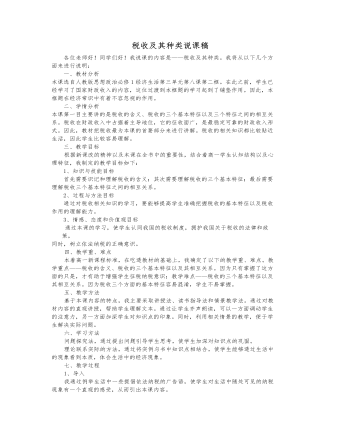
人教版高中政治必修1税收及其种类说课稿
在学生明确了税收的含义之后,我将分别对税收的三个基本特征进行解析。在讲解了之后,并分别用实例对其进行说明,加深学生对知识点的印象。最重要的是,总结出关键的字眼,使得学生能够清晰的区分出税收的三个基本特征。将强制性概括为依法征税、依法纳税;无偿性概括为不具有偿还性和返还型;固定性概括为规定应不应纳税、纳什么税、纳多少税。并跟学生指出,强制性是基本前提,无偿性是核心。由此根据书上的内容,推导出税收的三个基本特征相互之间的关系,即:三者缺一不可,统一于税法。而且,无偿性要求强制性,强制性保障无偿性;而无偿性与强制性又共同决定固定性。从而结束新课讲授。3、课堂总结根据板书内容重新回顾本课学习的主要内容,包括税收的含义,以及税收的三个基本特征和它们之间的相互关系。4、作业布置让学生预习税收的种类的内容,尤其是增值税和个人所得税。同时了解父母每月所缴纳的个人所得税和怎么计算的。
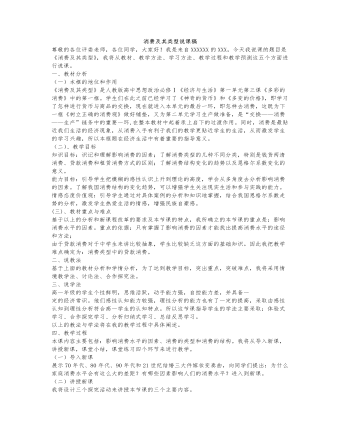
人教版高中政治必修1消费及其类型说课稿
(三)课堂小结接着进行课堂小结,先让学生自主总结,教师结合学生的总结,补充完善总结本节课的知识。并进行感情升华。这样设计课堂小结,是为了让学生学会自主总结知识,加深印象,教师总结帮助学生理清本课知识结构,并起到升华本节课的感情基调,落实教学目标。(四)课堂练习我将设计两道题让同学们做,巩固课堂知识。本课题板书设计我主要采用大纲的形式展现,让学生一目了然,便于识记和理解主干知识。五、教学预测最后我对本节课教学的效果进行预测:在这个教学过程中我都是从学生生活中感知的现象入手,设计情境,预设学生的分析,学生的体验,学生的感知,教师的点拨等。设计问题,学生自主合作探究,完成教学!通过这样的学习我想一定会收到较好的教学效果,当然,在实际的教学中,肯定也会出现一些意想不到的情况,我还会根据教学过程中的动态变化,及时地调整和修改预设内容。
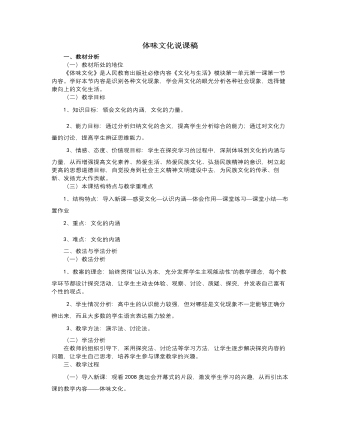
人教版高中政治必修3体味文化说课稿
3、文化的力量。为了使学生能辨证地分析文化的力量,我设计了两个问题进行探讨:(1)是不是任何文化都能起促进作用?(2)你在听或唱国歌时感受到一种什么样的力量?这样,学生在对比中学会辨证地分析文化的力量——先进的、健康的文化能促进社会发展和个人成长;落后的、腐朽的文化则阻碍社会发展和个人成长。同时还能提高学生的文化赏析能力,从而引导学生装自觉参加健康有益的文化活动,抵制不良文化的影响,投身到社会主义精神文明建设中去。关于课堂练习,我准备了5个针对性比较强的选择题,从而加深巩固本框题的重难点知识。最后,播放歌曲《走进新时代》,展示本课知识结构,指出本框题需重点掌握的问题,结束本课教学。课后作业,我设计了这样一个辨析的题目:文化是人们创造的全部财富的总和,它是人类特有的现象。

人教版高中英语必修4Body Language说课稿4篇
Textbook: Senior English for China (Book 4), by Liu Daoyi Time Allotment: 1 period (40 minutes)Date: March 20, 2014Teaching aids: blackboard, Multi-media, Power Point, chalk I. Text Analysis (教材分析)This unit is about body language, and the text selected in the reading part demonstrates the difference and similarity of body language in many parts of the world. Through learning this passage, students are required to raise their awareness of using body language in different parts of the world. As body language is closely related to our daily life, it is easy to arouse students’ interest in learning this text. Reading skills and speaking training are designed around the text.II. Teaching Objectives (教学目标)By the end of the lesson, students will be able to:1. Language Skill Objective(语言技能目标): develop reading ability (skimming and scanning)as well as speaking ability.2. Cultural Knowledge Objective(文化知识目标): know about the cultural differences of using body language.3. Affective Objective(情感目标): increase students’ awareness of using body language correctly in different cultures. III.Teaching Focuses and Difficulties(教学重点和难点)1. Teaching Focuses(教学重点): the difference and similarity of body language in many parts of the world.2. Teaching Difficulties(教学难点): develop students’ reading abilities of skimming and scanning and ask the students to show their opinions with fluent English.

人教版高中英语必修4Women of achievement说课稿4篇
Good morning, distinguished judges:It’s my honor to talk about my teaching ideas with you. Today my topic is Women of Achievement. My presentation consists of six parts: the analysis of teaching material and student, teaching aims, key and difficult points, teaching and studying method, teaching procedures and blackboard design.First, let’s focus on the analysis of teaching material. This lesson is from New Senior English for China Student’s Book 4 Unit 1, the reading part. The main topic of the passage is the introduction of a student of Africanwildlife. After this lesson, the students will learn more information about her studying chimps in Africa, and their reading and speaking abilities can be developed as well.The next part is the analysis of students. My students are in senior high students. They have learnt English for many years, they’ve known many words and sentences, but their speaking and reading abilities are still not very good. So I will practice their speaking and reading abilities through different exercises.According to the New Standard Curriculum and the present situation, I set the teaching aims as follows: firstly, knowledge aims. Students can grasp some new words, such as worthwhile, move off. Moreover, students can understand the content of the passage and get familiar with the topic of studying chimps in wildlife. Secondly, ability aims. Students can use reading strategies such as skimming and scanning in reading process. Thirdly, emotional aims. Students can have the awareness of protecting animals and care about animals.Based on the above analysis, the key point of this lesson is to get the main idea and the detailed information from the passage; the difficult point is to talk about the wildlife protection and use reading strategies.

人教版高中英语必修3Healthy Eating说课稿4篇
Language learning needs a context, which can help the learners to understand the language and then can product comprehensible output, so computer has the advantages to make the materials attractive.Part 3 Learning MethodsTask-based, self-dependent and cooperative learningPart 4 Teaching ProcedureStep One Lead-in“Interest is the best teacher.” Therefore, at the very beginning of the class, I should spark the students’ mind to focus on the centre topic “the band”. I’ll show some pictures of food to attract their attention and then bring some questions.Question:What kind of food they like?What should go into a good meal?The answers must relate to the diet. After this, the students will be eager to know something about a balance diet and this is the very time to naturally lead the class into Step 2Step 2 Reading for information: skimming and scanning In this step, I use Task-based Language Teaching method, which can give students a clear and specific purpose while skimming and scanning the context.Task 1 General ideaThe students will be asked to just glance at the title and the pictures of the passage, and then guess what they will read in the text. And they’ll be divided into groups of four to have a discussion.The purpose is to inspire the students to read actively, not passively. In addition, the task is to develop the students’ reading skill by making prediction and to encourage the students to express their thoughts in English and cooperate with each other.Task 2 Main idea of each paragraphCooperative learning can raise the students’ interest and create an atmosphere of achievement. Based on this theory, I divide the whole class into 4 groups to skim the whole text and get the main idea of each paragraph.

人教版高中英语必修5Great scientists说课稿4篇
通过写文章梗概,培养学生综合运用语言的能力,学习用恰当的英语描述科学家的故事。这是本课的教学难点。教师可以使用完形填空的方式来帮助学生整理语篇,从而来降低难度。本课的教学重点的突破方法是:在阅读前,让学生初步了解得出科学观点所需要的基本程序,从而轻松而自然地导入文章的阅读;在阅读过程中,由易到难设计快速阅读和精读的问题,层层推进各种阅读活动,让学生对阅读内容从整体感知到细节理解,最后深层读懂整篇文章,同时加强阅读策略的指导,让每个学生都主动参与课堂教学活动,最终达到提高阅读能力的目的。Step 4 Post-readingGroup Activities四人小组共同合作,在老师的适当指导下,就以下2个问题展开讨论,让学生就所知、所学、所感和所想融入话题,然后抽若干同学代表作小组发言。1. What do you think about John Snow, and what should we learn from him?2. Cholera was 19th century disease, which two diseases are similar to cholera today? Why?
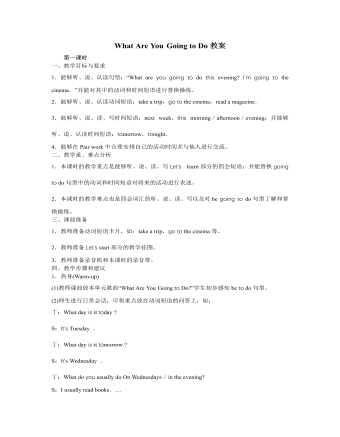
人教版新课标PEP小学英语六年级上册What Are You Going to Do教案
1.热身(Warm-up) (1)全班一起吟唱Let’s chant的歌谣。 (2)单词拼写竞赛 要拼写的单词包括:this morning/afternoon/evening,next week,newspaper, postcard等。可采取小组合作的“接龙式”拼写形式;也可以选取组内一名学生拼写全部单词。拼出单词最快最多的组获胜。 (3)教师出示简明地图,师生问答如下: r:What shop is it? s:It’s a bookstore. r:What can you buy in the bookstore? s:… 在学生回答各商店所出售的物品时,教师根据其回答贴出物品的小卡片,如: Fruit stand:orange,apple,pear,banana….Shoe store:sneakers,sandals,boots….(此时可引导学生说“a pair of sneakers/boots’’等) 2.预习(Preview) Let’s try 教师指着地图中的商店及各商店所出售的物品说:Look!There are so many stores and so many goods.Let’s listen to the tape and find out:①Where is Sarah going? ②What is she going to buy? ③Who is she going with? 教师放三遍Let’s try部分的录音,以上问题可根据学生的实际情况分三次提出,直到多数学生能回答并能将前两项答案填人教师课前画出的表格中。在填表过程中,教师请学生一起拼写其中的四会单词,如:bookstore,comic book。
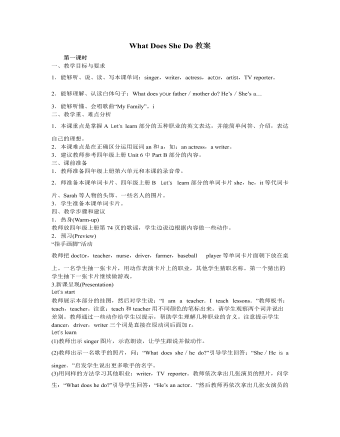
人教版新课标PEP小学英语六年级上册What Does She Do教案
(3)教师就黑板上的内容和学生做对话练习,如:What does your mother do?Where does she work?How does she go to work?教师板书“Where does she work?”和“How does she go to work?”,示范朗读,学生跟说。学生两人一组根据黑板上的语言提示做对话练习。 (4)“看卡片,说句子”活动 教师面前放一摞单词卡片,依次为:职业名称卡片,工作地点卡片和交通方式卡片。活动开始,教师随意从第一摞卡片中抽取一张职业卡片,如:engineer,举起来问:“What does your father do?”学生回答“He’s an engineer.”教师继续抽取一张工作地点卡片,举起来,如:Car company,问:“Where does he work?”学生说:“He works in a Car company.”教师再抽取一张交通方式卡片,如:bus,问:“How does he go to work?学生回答:“He go es to work by bus.”游戏进行几轮后,可以请几名学生轮流代替教师抽卡片,提问题。 (5)教师放本部分的录音,学生跟读。学生两人一组读课文对话。 (6)学生两人一组做对话替换练习。 (7)教师指导学生书写四会句子。 4.巩固和延伸(Consolidation and ex tension) Group work
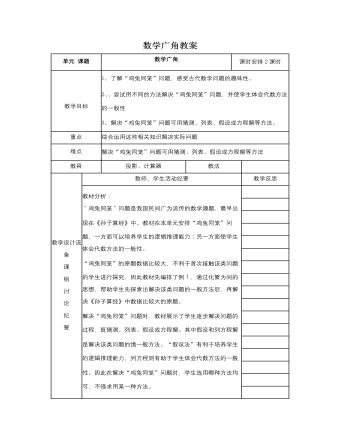
人教版新课标小学数学六年级上册数学广角教案
教材分析:"鸡兔同笼"问题是我国民间广为流传的数学趣题,最早出现在《孙子算经》中。教材在本单元安排“鸡兔同笼”问题,一方面可以培养学生的逻辑推理能力;另一方面使学生体会代数方法的一般性。“鸡兔同笼”的原题数据比较大,不利于首次接触该类问题的学生进行探究,因此教材先编排了例1,通过化繁为间的思想,帮助学生先探索出解决该类问题的一般方法后,再解决《孙子算经》中数据比较大的原题。解决“鸡兔同笼”问题时,教材展示了学生逐步解决问题的过程,既猜测、列表、假设或方程解。其中假设和列方程解是解决该类问题的饿一般方法。“假设法”有利于培养学生的逻辑推理能力,列方程则有助于学生体会代数方法的一般性。因此在解决“鸡兔同笼”问题时,学生选用哪种方法均可,不强求用某一种方法。
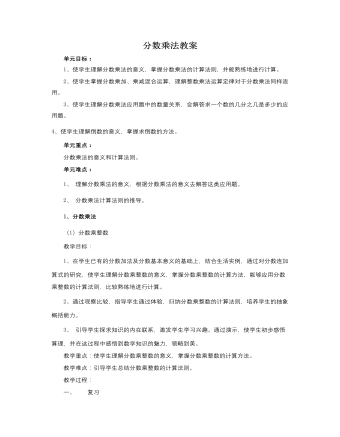
人教版新课标小学数学六年级上册分数乘法教案
3、教学例3(1)读题理解题意后,提出“婴儿每分钟心跳的次数比青少年多 ”表示什么意思?(组织学生讨论,说说自己的理解)(2)引导学生将句子转化为“婴儿每分钟比青少年多跳的次数是青少年每分钟心跳次数的 ”。着重让学生说说谁与谁比,把谁看作单位“1”。(3)出示线段图,学生讨论交流,结合例2的解题方法,学生独立列式计算后全班交流两种解题方法。解法一:75+75× =75+60=135(次)解法二:75×(1+ )=75× =135(次)4、巩固练习:P21“做一做”(列式后让学生说说算式各部分表示什么)三、练习1、练习五第2、3题:引导学生抓住题目中关键句子分析,找到谁与谁比,谁是表示单位“1”的量。2、练习五第3、4题:学生依据例题引导的解题方法,独立完成3、4题。四、布置作业练习五第7、8、9、10题。
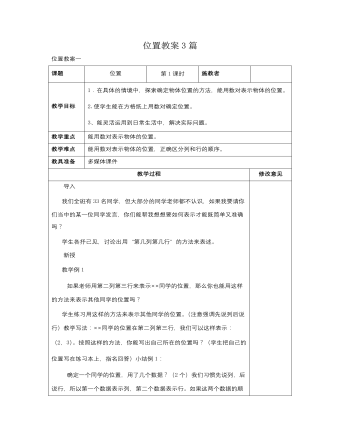
人教版新课标小学数学六年级上册位置教案3篇
【教学过程】一、从实际情景入手,引入新知,使学生学会在具体情景中用数对确定位置1.谈话引入。今天有这么多老师和我们一起上课,同学们欢迎吗?老师们都很想认识你们。咱们先来给他们介绍一下我们班的班长,可以吗?2.合作交流,在已有经验的基础上探究新知。(1)出示要求:以小组为单位,想一想,可以用什么方法表示出班长的位置,把你的方法写或画在纸上。汇报:班长的位置在第4组的第三个,他在从右边数第二组的第三排…哪个小组也用语言描述出了班长的位置?请班长起立,他们的描述准确吗?刚才同学们的描述有什么相同和不同?(都表示的是班长的位置,有的同学说第几组,第几行,第几排……)看来在日常生活中,我们可以用组、排、行、等多种方式,还可以从不同的方位来描述物体的位置。为了我们在确定位置的时候语言达成一致,一般规定:竖排叫列,横排叫行。
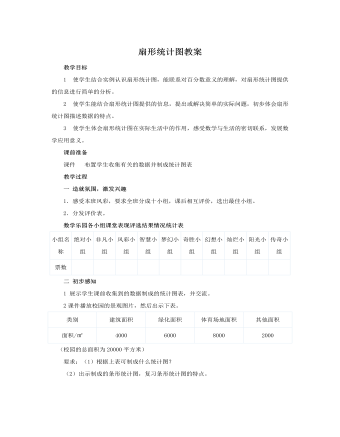
人教版新课标小学数学六年级下册扇形统计图教案
2 根据下面4幅,你能判断出哪个学校的女生人数最多吗?(1) 如果甲校的学生总人数900人,那么甲校的女生有多少人?(2) 如果丙校男生与甲校的同样多,那么丙校学生总人数有多少人?(3) 如果乙校的学生总人数与丙校的同样多,那么乙校男生有多少人?(4) 如果丁校的男生与乙校的同样多,那么乙校的女生有多少人?3 出示课件《中国人口占世界的百分比》和《中国国土面积占世界的百分比》统计图和有关的数据。(1)中国人口约13亿 (2)中国国土面积约960万平方千米(请同学认真观察统计图和有关的数据,请你说说获得了哪些信息?并提出我们能够解决的问题。要求:先在小组交流,然后派代表提出问题,并指定他组回答,其他同学当评委;如果回答正确,由的同学提问题,否则,由提问题的同学继续提问。同组成员可帮助。)还有什么想法?3 出示西山村果园各种果树种植面积情况,要求学生根据给出的数据制成扇形统计图。
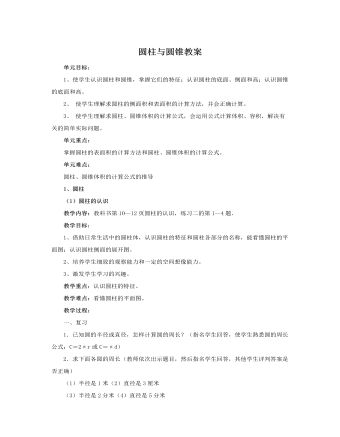
人教版新课标小学数学六年级下册圆柱与圆锥教案
(2)圆锥的体积教学内容:第25~26页,例2、例3及练习四的第3~8题。教学目的:1、 通过分小组倒水实验,使学生自主探索出圆锥体积和圆柱体积之间的关系,初步掌握圆锥体积的计算公式,并能运用公式正确地计算圆锥的体积,解决实际生活中有关圆锥体积计算的简单问题。2、 借助已有的生活和学习经验,在小组活动过程中,培养学生的动手操作能力和自主探索能力。3、 通过小组活动,实验操作,巧妙设置探索障碍,激发学生的自主探索意识,发展学生的空间观念。教学重点:掌握圆锥体积的计算公式。教学难点:正确探索出圆锥体积和圆柱体积之间的关系。教学过程:一、复习1、圆锥有什么特征?(使学生进一步熟悉圆锥的特征:底面、侧面、高和顶点)
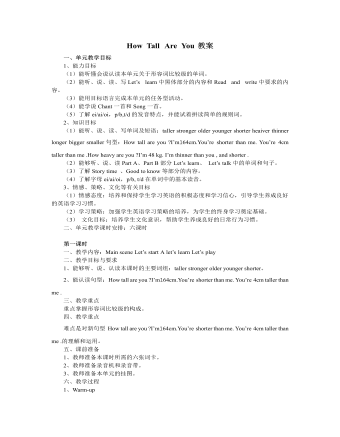
人教版新课标PEP小学英语六年级下册How Tall Are You教案
(1)呈现猴子图片,初步接触知识.教师在发指令时,加入 Touch your tail.当学生觉得茫然时,老师趁机出示课件(一只猴子)Look,We have no tails,but the monkey has.Look at the monkey,How long is the tail?在课件上呈现数据38cm.学生回答:Its tail is38cm long.根据教材内容教师提问:How tall is the monkey?学生:It’s 40cm tall.老师自己引出only一词,注意这个词的发音.多媒体再出示两只猴子的图片,一只黄色,一只棕色,让学生加以比较.教师问:Which monkey do you like?The yellow one or the brown one?【设计思路】 学生在回答这些问题时,也同时在复习前两课时所学内容,起到知识循环的作用.(2)猜一猜游戏:它们有多高?让学生猜一猜这两只猴子的身高.注意提示学生用上I think….这一句型,表示自己的猜测.在这里也可安排一个竞赛,看谁能猜中正确数据,教师让一些学生猜后出示数据.【设计思路】 学生对有悬念的东西都特别感兴趣,在此不仅练习了两位数的读法,又满足了学生的好胜心理.

人教版新课标PEP小学英语六年级上册How do you go there教案
教师检查有多少学生能够准确区分14与40的发音,如果答对率低,教师要注意纠正。教师还可以板书一组相似的数字,如:13/30,18/80,15/50,教师说英文,学生说出中文的数字,帮助学生区分/-ti:n/与l-u/。 3.新课呈现(Presentation) Let’s talk (1)教师根据学生平时常去的场所提问,如当地的一家电影院、风景点、或学生的祖父母家等:“How can you get to…? Can you go by …? Is it fast/slow/expensive to go by …? ”进行师生间的自由会话,再让学生感知一下新句型:How can I/ you get to…? 然后,教师请学生根据课本中提供的地图回答问题:“How can I get to Zhongshan Park? ”引导学生回答,提示他们坐15路公交车为:“By the No.15 bus.”教师提供完整的答句:“Yes.I can go by the No.15 bus.”教师板书这组句子。 (2)教师继续提问:“It’s a place.You can buy food,drink,fruit,veget ables,school things and clothes there.What is it? (It’s a supermarket.)”教师最好出示一张当地比较有名的超市的照片或图片来给出谜底。教师再提问:“How can I get there? By bus or by bike? ”然后领读句子:“I can go to the supermarket by …”帮助学生理解supermarket是一个合成词,来源于super与market。

人教版新课标PEP小学英语六年级上册I Have a Pen Pal教案
(1)教师说:“Zhang Peng’s mother is a teacher.What does she teach? Does she teach English?”教师出示Let’s talk部分的挂图,放录音,学生听录音阅读对话。教师出示主句型:Does he/she…?Yes,he/she does.No,he/she doesn’t.然后教师引导学生回答刚刚提出的问题,逐步掌握肯定和否定回答。再放一遍, 学生跟读. (2)教师说:“My mother is a teacher,too.Do you want to know more about her.Ask me some questions.”教师依次出示B Let’s learn部分的单词卡片,提示学生根据上面的短语和黑板上的重点句型提问,教师作答。 (3)教师指导学生进行替换练习。必要时,提示学生可以换一下对话里的人物,f 如:Does your uncle live in the city? Yes,he does.Does your grandma live in the country? No,she doesn’t. (4)“寻找家园”游戏 教师准备一些卡片,正面写有人名,反面写有地名,如:city,country,village,farm,forest,mountain,nature park等。请一名学生上台抽取一张卡片,问台一学生:“Guess.Where does…live?’’学生猜:“Does he/she live in/on…?”猜对的小组得一分。
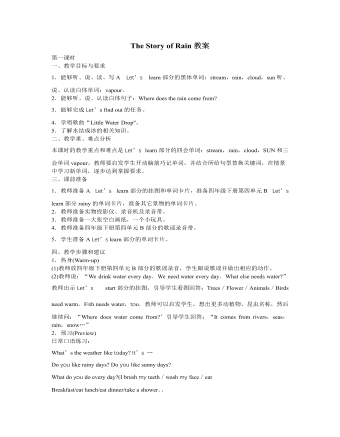
人教版新课标PEP小学英语六年级上册The Story of Rain教案
(2)教师说:“I am going to plant a flower on the weekend.But I don’t know hoⅥ do that.Can you tell me? Who knows?”教师提示学生可以适当用中文解释。如果有学生举手,教师就问:“OK.How d0 you do that?”引导学生回答。“First,put the seeds in the soil.”然后,教师接着说:“What should I do then? 引导学生回答“Water it. (3)教师说:“Zhang Peng is talking to h is teacher.Now Let’s see what they talking about.”学生翻开学生用书,教师放录音,学生跟读。教师解释In several days的意思是几天以后。”教师板书四会句型:How do you do that? What should you do then?学生仿写。 (4)同桌学生进行对话替换操练,可以谈论西瓜(watermelon)、小麦(wheat)等植物的种植过程。然后选几组在班上表演对话。 (5)教师指导学生运用主句型编对话。以下对话供参考: A:How do you clean the classroom? B:First.sweep the floor. A:What should you do after that? B:Then clean the desks and chairs.wash the windows. 4.巩固和延伸(Consolidation and extension) (1)做本单元B Let’s talk部分的活动手册配套练习。
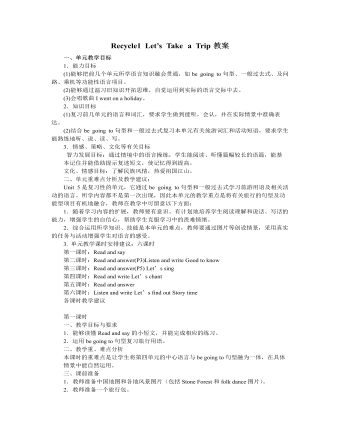
人教版新课标PEP小学英语六年级下册Recycle1 Let’s Take a Trip教案
4.巩固和扩展(Consolidation and extension) (1) 做本单元活动手册配套练习。 (2) 翻卡片说单词。学生两人一组,把单词卡片反面朝上放在桌子上,然后同时翻开两张单词卡(如:going, holiday),就马上组织成一句话(如:Where are you going on the holiday?/ I’m going to Kunming this holiday.),说得快又正确者为胜。 (3) 教师播放C部分Story time的录音或VCD,帮助学生理解故事内容。学生再听一遍录音,跟读故事里的句子,教师指导学生发音。 (4) Bright eyes. 在黑板上张贴Let’s find out的8幅图片,Mike, Zhang Peng, Sarah, Kathy等4个人物图片分别放在8幅图片上,如:Mike ---take pictures---buy presents。学生仔细观察后,请学生闭上眼睛,教师就趁学生闭眼之际交换人物位置(如把Mike放到eat noodles),然后请学生张开眼睛回答:What did Mike do just now ? 引导学生回答: Mike took pictures and bought presents. 教学参考资料库 1.文化背景介绍: 机场标志: Airport 飞机场 Airport lounges 机场休息室Airports shuttle 机场班车 Arrivals 进港Assistance 问讯处Check in area (zone) 办理登机区Departure airport 离港时间Departure times on reverse 返航时间 Welcome aboard 欢迎登机

人教版新课标PEP小学英语六年级下册What’s the Matter, Mike教案
回答:She’s sad. She failed the math test.并板书:fail the math test。准备一张很糟的数学试卷,是学生了解语意。进一步教学其他短语a Chinese test, a English test,并 让学生了解pass the Chinese test, pass the English test, pass the math test. (4)教师请学生扮演Sarah,师生对话如下: T: Hello! Sarah, how are you? You look sad today. Sarah: Yes, I failed the math test. 教师接着说:I’m sorry to hear that.让学生理解意思。并引申出句子:I’m glad to hear that.让学生分角色朗读对话。 (5)Let’s check.让学生看Sarah的表情,并读两篇对话,选出正确的答案。 (6)活动名称:心理医生 活动目的:操练句型“How are you? You look…”.学生间自由组合编排对话.通过对话对学生展开情感教学,让学生理解健康的体魄和愉悦的心情的心情是一个人成功的重要因素,使学生形成良好的心理健康状态。 活动过程:A: How are you? You look bored today. B: Yes. I failed my math test. A: I’m sorry to hear that. Believe yourself. Work hard. You can pass the text next time. (7)活动名称:难忘时刻 活动目的:围绕照片上的表情展开询问和讨论.操练句型 “How do you feel? How does she/he feel?